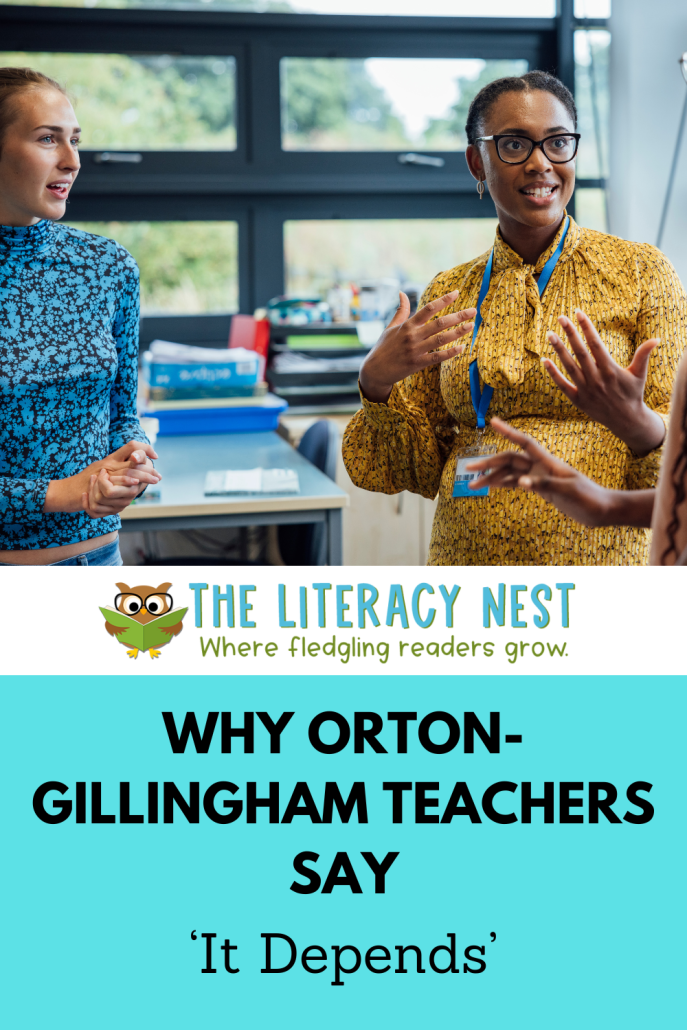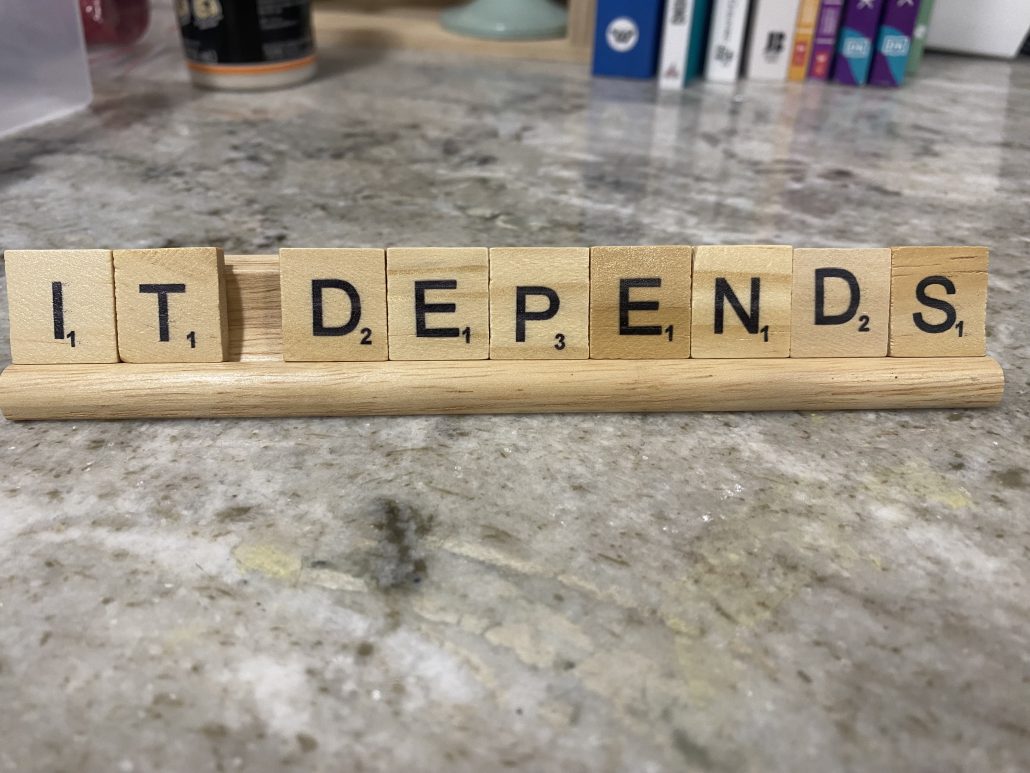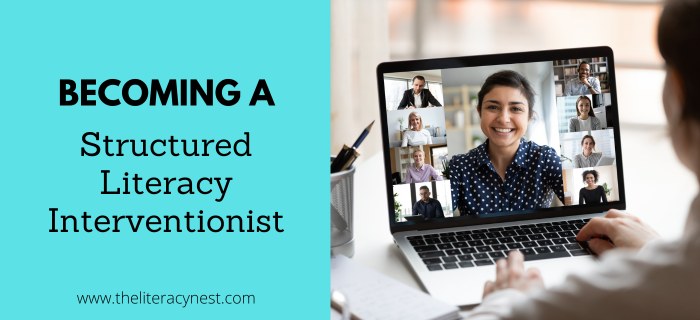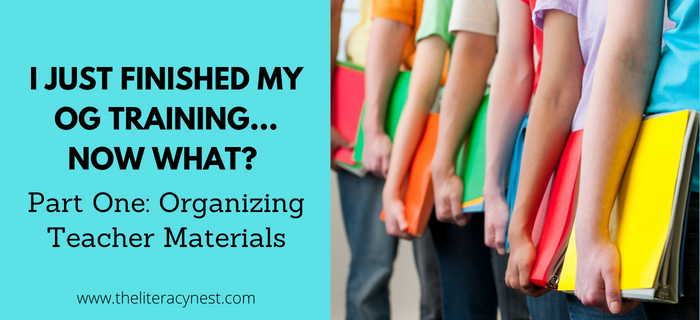Why Orton-Gillingham Teachers Say ‘It Depends’
If you’ve spent any time in Orton-Gillingham circles, there’s one phrase you’ve probably heard again and again:
“It depends.”
You might hear it when you ask:
- “How long should I stay on closed syllables?”
- “Is this student ready for vowel teams?”
- “How many words should I include in dictation?”
- “Can I really teach all of this in a 45–60 minute lesson?”
And the answer from your trainer, mentor, or a more experienced colleague is often a gentle but firm:
“It depends.”
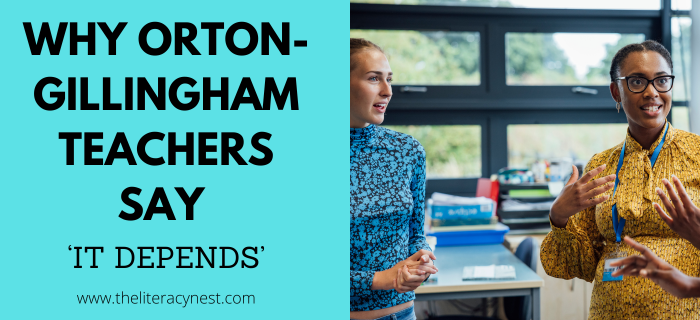
For many OG-trained teachers, that response can feel vague, confusing, or even a little frustrating. You’ve invested time, money, and energy into training. You’d love some clear yes/no answers!
But here’s the truth: in the OG community, “it depends” is not a cop-out. It’s actually a powerful reflection of what makes this approach so effective for dyslexic learners.
In this post, let’s unpack why we say “it depends” so often, and why that little phrase really matters.
Why “It Depends” Is So Common in OG
Orton-Gillingham isn’t a scripted program. It’s an approach that is intentionally diagnostic and prescriptive.
That means you aren’t simply marching through a pre-set sequence and checking boxes. Instead, you are:
- Observing the learner in front of you
- Noticing patterns in their errors and strengths
- Making instructional decisions based on what you see
When someone says, “It depends,” they’re really saying:
“I can’t answer that well without knowing more about this learner and this context.”
OG is built to be responsive. The answer that’s just right for one student might be completely inappropriate for another. “It depends” is a reminder that we must start with the child, not the lesson plan.
What Does “It Depends” Actually Depend On?
When you ask a question about pacing, lesson design, or what to do next, there are several layers that experienced OG teachers are mentally working through. Let’s walk through a few of them.
The Student’s Profile
Every dyslexic learner brings a unique profile to the table. Some things we’re considering:
- How severe are their reading and spelling challenges?
- Are there co-occurring factors like ADHD, language disorders, anxiety, or processing weaknesses?
- How old are they, and how long have they been struggling?
A second grader just beginning intervention and a high school student who has been compensating for years may both have dyslexia, but they will need very different decisions from you.
So when you ask, “Should I move on?” it’s natural for the answer to be, “It depends on this student’s profile.”
Assessment and Response to Instruction
The diagnostic part of OG isn’t just about formal testing. It’s also about what you see every single lesson.
Some of the questions we ask ourselves include:
- What error patterns are showing up in reading and spelling?
- Is the student accurate, or are they still guessing?
- How automatic are they with a concept? Do they need lots of wait time, or is it starting to come quickly?
- Can they transfer this skill to connected text and to writing?
So when you ask, “Can I move on from closed syllables?” the more complete answer becomes:
“It depends on how accurate and automatic they are, and whether they can apply that knowledge in both reading and spelling.”
Lesson Setting and Logistics
Your teaching context also plays a big role in those “it depends” answers:
- Are you working 1:1 or in a small group?
- Do you have 30 minutes, 45 minutes, or a full hour?
- Do you see students daily, a few times a week, or only once a week?
A concept that feels manageable with four 1:1 sessions per week may not be realistic if you’re only seeing a small group once a week. The same scope and sequence will play out very differently in different settings.
So when you ask, “Can I fit all of this into one lesson?” the honest response is usually:
“It depends on your time, group size, and how often you see them.”
The Guardrails: What Doesn’t Change in OG
All of this flexibility does not mean OG is a free-for-all. There are important non-negotiables that anchor us:
- Instruction is systematic and cumulative
- Concepts are taught explicitly
- Lessons are multisensory in a purposeful way
- Teaching is diagnostic and prescriptive, not scripted and rigid
Within those guardrails, there is room to flex:
- How quickly you move through the scope and sequence
- How much review you include in a particular lesson
- Which words, sentences, and texts you choose
- How many items you include in dictation or reading practice
- Which multisensory routines you lean on most often
So if you ask, “Can I change this part of the lesson?” the real answer is:
“It depends. As long as the OG principles stay intact, there is space to adapt the details.”
Why “It Depends” Actually Protects Your Students
It can be tempting to wish for a simple rule you can follow forever, like, “Spend exactly three weeks on each concept,” or “Always introduce syllable types in this exact timing.”
But “it depends” protects you from a few common traps.
It Keeps the Child, Not the Program, at the Center
When we rely on rigid timelines, it’s easy to slip into:
- “This is Lesson 12, so I must do X,”
rather than, - “Given what I’m seeing, what does this learner need next?”
“It depends” gently steers us back to the child as our starting point. That’s exactly where OG is meant to begin.
It Helps You Avoid Rushing and Stalling
Without a diagnostic mindset, we can either:
- Rush forward just because we feel “behind,” or
- Stay stuck on one concept far longer than necessary because we’re not sure when it’s safe to move on.
“It depends” isn’t a stall tactic. It’s an invitation to ask yourself:
- Are they accurate with this skill?
- Are they becoming more automatic, or still laboring over each item?
- Can they apply it across reading, spelling, and connected text?
Your answers to these questions will tell you much more than an arbitrary schedule ever could.
It Honors the Complexity of Teaching Dyslexic Learners
If you’ve felt uncomfortable hearing “it depends,” you’re not alone. So many OG teachers secretly wonder:
“Why can’t anyone just tell me exactly what to do?”
But the reality is, your work is complex, professional work. It requires:
- Careful observation
- Pattern recognition
- Problem-solving
- Judgment and reflection
When a trainer says, “It depends,” they’re honoring the fact that there is no one right move for every learner, and that your thinking matters.
Turning “It Depends” Into Practical Next Steps
So what do you do with this phrase in your daily teaching life? Let’s make it concrete.
1. Add Student Details to Your Questions
If you’re asking a mentor for help, try framing your questions with more diagnostic information.
Instead of:
“Should I start vowel teams now?”
Try something like:
“My student is 95–100% accurate with closed syllables in reading, but still makes some short vowel errors in spelling. We’ve reviewed for about four weeks, and they’re starting to read closed-syllable words more fluently. Would you begin vowel teams now, or spend more time stabilizing spelling first?”
You’re already doing the OG thinking, and your mentor can give a much richer answer than a simple yes or no.
2. Use a Quick Self-Check Before You Decide
When you’re making your own instructional decisions, you might pause and ask:
- Accuracy: Are errors rare, and do they self-correct easily?
- Automaticity: Are they still painstakingly slow, or starting to respond more fluently?
- Application: Can they use the skill in isolation and in connected text and writing?
- Cognitive Load: Will adding something new overload them, or can they reasonably handle it?
If your answers suggest readiness, moving on makes sense. If not, you know where to lean in.
3. Anchor Yourself in the Core OG Principles
When in doubt, come back to the heart of OG:
- Am I remaining systematic and cumulative?
- Am I being explicit in my teaching, not assuming students will “pick it up”?
- Am I using multisensory routines in a meaningful way, not just for fun or decor?
- Am I truly being diagnostic and prescriptive, or just following a script?
If those anchors are in place, then “it depends” starts to feel less like uncertainty and more like professional freedom.
Reframing “It Depends”
What if we started to hear “it depends” as an invitation instead of a dead end?
An invitation to:
- Look more closely at the learner in front of you
- Gather and reflect on assessment data
- Trust your growing knowledge of structured literacy and OG
- Collaborate with others using rich, student-centered details
The truth is, there is no single perfect move for every dyslexic learner. There is simply the next best step for this student, in this moment, with you as their teacher.
And that is where your expertise, your training, and your heart for your students truly shine.
If you’d like a companion resource to this post, you can turn these ideas into a simple reflection tool:
- Choose one student.
- Jot down their current strengths, challenges, and data.
- Ask yourself, “Given all of this… what should I do next?”
Chances are, your own thoughtful answer will begin with:
“Well… it depends.” And that’s exactly what makes your teaching so powerful.
If you stand by this phrase…
I have a fun little treat for you! Order your ‘IT DEPENDS’ letter tile tray and I’ll ship one to you! (US residents only) It makes a great gift for that special O-G teacher, trainer or trainee in your life. All letter tiles are glued to the tray.
